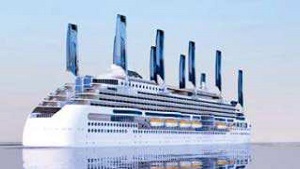Peace Boat and DNV GL sign Ecoship Agreement
At the SMM trade fair on Tuesday, Peace Boat, the Japan-based international non-profit NGO, and classification society DNV GL signed an MOU forming a partnership to develop the Ecoship cruise ship.
The MOU will see the partners work together on the design, construction and operation phases of Peace Boat’s Ecoship and the promotion of the Ecoship as a flagship for climate action, the Sustainable Development Goals and for sustainability in shipping.
 With the Ecoship, Peace Boat set out to create a vessel design and a set of specifications that incorporates the latest environmentally friendly technologies. It aims to be out in front of incoming regulations and to offer a transition model towards a low-carbon economy.
With the Ecoship, Peace Boat set out to create a vessel design and a set of specifications that incorporates the latest environmentally friendly technologies. It aims to be out in front of incoming regulations and to offer a transition model towards a low-carbon economy.
The process began in 2014 in Hamburg where shipping and non-maritime experts worked together to develop a whole-system integrated design approach, based on the belief that elements of a system work best when they are specifically designed to complement rather than compensate for each other.
“The cruise industry is growing so fast, particularly in East Asia, and the need to mitigate the environmental impact of such expansion is very important,” says Yoshioka Tatsuya, Founder and Director of Peace Boat. “Through its technical characteristics and in the programs that it carries out we hope it will encourage a model for green cruising and further innovations in the cruise industry.”
Architectural naval design company Oliver Design has based the Ecoship design on biophilic principles – using the solutions nature has evolved. The Ecoship design incorporates cutting edge technology to improve efficiency, reduce waste and minimize environmental impacts.
Some of the most notable features include: ten masts to harness wind energy for propulsion, solar panel-covered sails and a 6,000m2 top-deck solar farm, a closed-loop water system to reuse, purify and re-purpose water and waste heat recovery systems where it is hoped that 80 percent of the energy normally lost in the air and in the water can be reclaimed for use.
The 55,000gt vessel will include an on-board garden featuring plants from around the world fed by rainwater and organic waste. Plans are underway for a non-toxic, anti-fouling hull coating that mimics fish skin.
The vessel will be dual-fuel with diesel-electric pods for propulsion as well as featuring a wind energy system. Energy storage will be managed through a combination of the latest technology for batteries and hot and ice storage tanks.
An onboard research laboratory will further study of climate change and act as an ocean observatory.
The vessel will be ice class – the plans call for a Type C vessel and IMO PC7 ice class with –10 °C design temperature.
Peace Boat is a global non-government organization headquartered in Japan established for the purpose of raising awareness and building connections internationally among groups that work for peace, human rights, environmental protection and sustainable development.
Peace Boat's first voyage was organized in 1983 by a group of Japanese university students as a creative response to government censorship regarding Japan's past military aggression in the Asia-Pacific. They chartered a ship to visit neighboring countries with the aim of learning first-hand about the war from those who experienced it and initiating people-to-people exchange.
Since then, the Tokyo-based organization has launched 25 international voyages of passenger ships manned by international volunteers that travel particularly to areas that are experiencing or have experienced unrest. These cruises, the main operation of the Peace Boat organization, are on average carried out at least twice a year.

